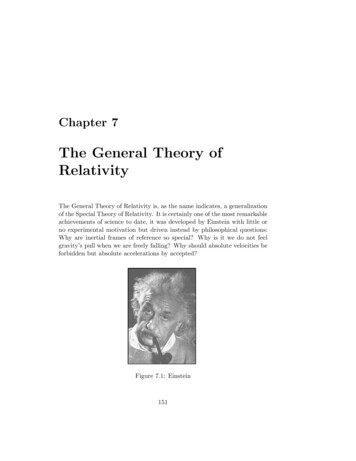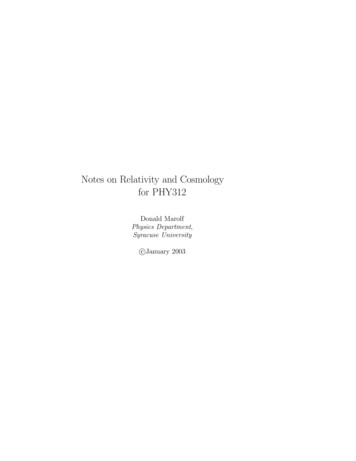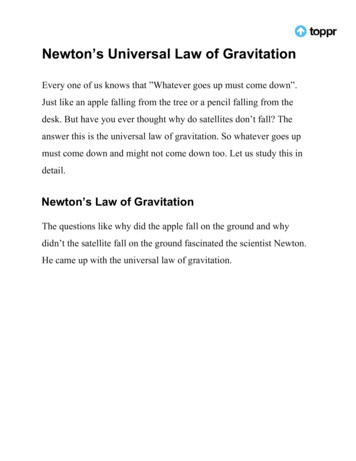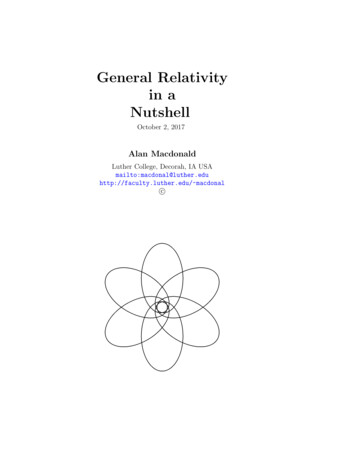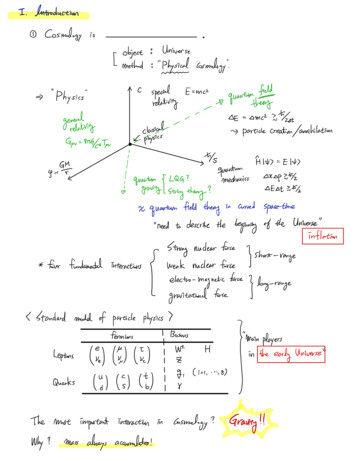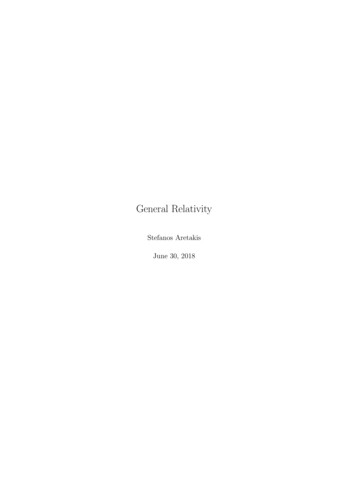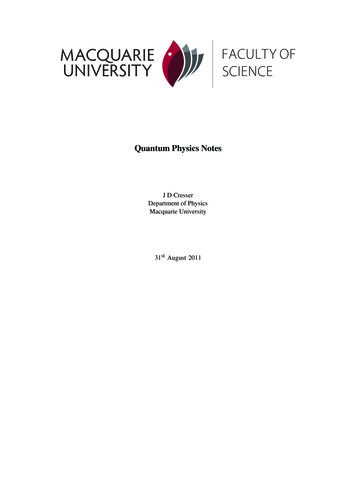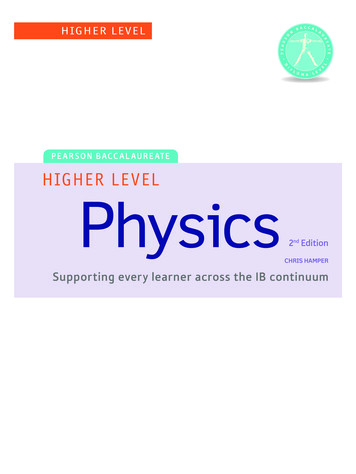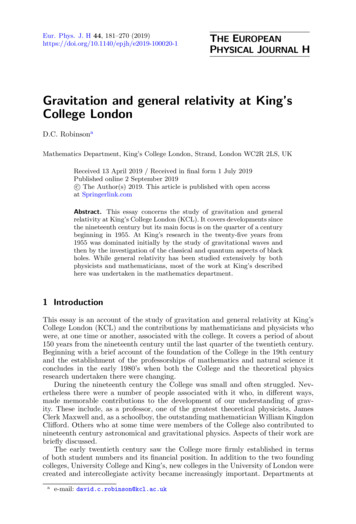
Transcription
Eur. Phys. J. H 44, 181–270 HE EUROPEANPHYSICAL JOURNAL HGravitation and general relativity at King’sCollege LondonD.C. RobinsonaMathematics Department, King’s College London, Strand, London WC2R 2LS, UKReceived 13 April 2019 / Received in final form 1 July 2019Published online 2 September 2019c The Author(s) 2019. This article is published with open accessat Springerlink.comAbstract. This essay concerns the study of gravitation and generalrelativity at King’s College London (KCL). It covers developments sincethe nineteenth century but its main focus is on the quarter of a centurybeginning in 1955. At King’s research in the twenty-five years from1955 was dominated initially by the study of gravitational waves andthen by the investigation of the classical and quantum aspects of blackholes. While general relativity has been studied extensively by bothphysicists and mathematicians, most of the work at King’s describedhere was undertaken in the mathematics department.1 IntroductionThis essay is an account of the study of gravitation and general relativity at King’sCollege London (KCL) and the contributions by mathematicians and physicists whowere, at one time or another, associated with the college. It covers a period of about150 years from the nineteenth century until the last quarter of the twentieth century.Beginning with a brief account of the foundation of the College in the 19th centuryand the establishment of the professorships of mathematics and natural science itconcludes in the early 1980’s when both the College and the theoretical physicsresearch undertaken there were changing.During the nineteenth century the College was small and often struggled. Nevertheless there were a number of people associated with it who, in different ways,made memorable contributions to the development of our understanding of gravity. These include, as a professor, one of the greatest theoretical physicists, JamesClerk Maxwell and, as a schoolboy, the outstanding mathematician William KingdonClifford. Others who at some time were members of the College also contributed tonineteenth century astronomical and gravitational physics. Aspects of their work arebriefly discussed.The early twentieth century saw the College more firmly established in termsof both student numbers and its financial position. In addition to the two foundingcolleges, University College and King’s, new colleges in the University of London werecreated and intercollegiate activity became increasingly important. Departments atae-mail: david.c.robinson@kcl.ac.uk
182The European Physical Journal HKing’s were re-organized; mathematics and physics departments were introduced andthe physics department in particular attracted some outstanding people. By the timeEinstein visited the College in 1921 the popular press had published articles abouthis new theory of gravity and his visit was a notable event. Although the generaltheory of relativity was still little understood by most physicists it was already beingstudied at King’s; William Wilson in the physics department had published work onthe theory in 1918.Subsequently, and for most of the twentieth century research at King’s on general relativity was carried in the mathematics department beginning with the work ofGeorge Jeffery in the 1920s. People working on the subject would have been appointedas applied mathematicians but that term was broadly interpreted and included mathematical or theoretical physics and cosmology. Most of those working on generalrelativity at King’s in the inter-war years also carried out research on other topics.Indeed they often did their most important work in other areas. Their gravitationalresearch, even if it was not always of enduring significance, ensured a continuity ofinterest in general relativity in the College. This was not without importance, particularly in the period, from about 1930 to 1950, when general relativity was littlestudied and exciting developments in quantum mechanics were of central interest totheoretical physicists. Jeffery became noted for his early translations of importantrelativity papers and his research on plane gravitational waves. George Temple andGeorge McVittie, whose work included research on cosmology and general relativity,came to the mathematics department in the 1930s but spent years away during thesecond world war. For them, as for others, the war disrupted everything. Many people were absent from King’s for long periods and for a time the College had to beevacuated from London.In the decade after the end of the war there was a slow but steady renewal ofinterest in general relativity. New centres of research into the subject were establishedand one of these was at King’s. In 1954 Hermann Bondi arrived to replace Templeas the professor of applied mathematics and he quickly formed a research groupconsisting initially of himself, Clive Kilmister who was already at King’s and FelixPirani who arrived the following year. The work of the relativity group at King’s,from Bondi’s arrival until the beginning of the 1970s, forms the central part of thisessay.Formation of a group devoted to the study of gravitation was a new and majordevelopment for the still small mathematics department. It coincided with the end ofa long quiet period in the study of general relativity. The Berne conference in 1955marked the end of that period while the renewal of the subject was celebrated by theChapel Hill conference in 1957. Both meetings were important for Bondi and Piraniand they had a big influence on the way the King’s group developed.Bondi was a man of many parts and his influence was widely felt, not only inthe expanding world of general relativity, but also in the wider scientific and political community. During his time at King’s the general relativity group became animportant international research centre attracting many short and long term visitors. In the Bondi years old uncertainties about gravitational radiation were resolvedand new and fruitful insights were developed. Work on gravitational radiation goesback to Einstein and his foundational work on the subject in 1916 and 1918. Howeverin subsequent years confusion about the existence of gravitational waves arose. Themajor advances in the study of gravitational waves at King’s (and elsewhere of course)were made by Bondi, Pirani, their students and a number of visitors and researchassociates. The latter included Andrzej Trautman, Ivor Robinson, Ray Sachs, JoshGoldberg, Roger Penrose and Ted Newman.The 1960s saw the discovery of quasars, the cosmic black body radiation, pulsarsand the naissance of experimental work on gravity. These brought general relativityback in from the cold, slowly but steadily back into the mainstream of astrophysics
D.C. Robinson: Gravitation and general relativity at King’s College London183and physics. The discovery of quasars and the black body radiation sounded, formost, the death knell for the steady state theory of the universe. Bondi, Pirani andothers at King’s who had been supporters of the theory had regarded the fact thatthe theory made predictions which could be disproved as one of its strengths so theyquietly accepted this. The work on gravitational radiation and these new developments led into the radically new work of Roger Penrose on the global structure ofspace-time, gravitational collapse and space-time singularities. Together with StephenHawking, Robert Geroch and others Penrose introduced the innovative use of topology and modern differential geometry into relativity. A distinctly post-Einstein erahad arrived.The new astrophysical observations encouraged the study of black holes. Vigorously promoted by John Wheeler at Princeton, they became a topic of central interestin general relativity. The group at King’s responded to the new theoretical developments in different ways, as did relativists in general. Some were enthusiastic aboutthem, others had reservations. As the 1960s progressed while Bondi become increasingly involved in external activities the relativity group expanded. Three youngerpeople, Peter Szekeres, Michael Crampin and Ray d’Inverno, took up mathematicslectureships in the second half of the 1960s and pursued research on gravitationalwaves, applications of modern differential geometry and algebraic computing appliedto general relativity.There were further changes to the King’s group in the early 1970s. Between 1970and 1973 Szekeres, Crampin and d’Inverno left to be replaced in the relativity groupby myself and Paul Davies. Bondi left in 1971, although he retained formal linkswith the College. He was replaced by John G. Taylor whose primary research areathen was quantum field theory. He also worked on neural networks and subsequentlyon supersymmetry and string theory. Chris Isham, a quantum field theorist withactive interests in general relativity, joined the department in 1973 and contributedsignificantly to the relativity group.A second period of vigorous activity at King’s took place in the 1970s. Manyin the King’s group became centrally concerned with the theory of black holes andparticularly with the new insights being produced by Stephen Hawking and others.Research was undertaken into both the classical regime, with astrophysical bodies inmind, and the quantum mechanical regime. I was involved in research on uniquenesstheorems for classical black holes. Davies’ and Isham’s work mainly concerned studiesof quantum field theory in curved space-times and other aspects of quantum fieldtheory and gravity. As in the 1960s there were post-docs and visitors who mademajor contributions to these lines of research. They included Henning Müller zumHagen, Steve Fulling, Steve Christensen, Mike Duff, Stanley Deser and Larry Ford.Research students also did important work, particularly in the newly developing areaof quantum field theory in curved space-times.By the early 1980s Isham and Davies had left King’s. While work on generalrelativity and topics such as Penrose’s twistor theory, pursued at King’s by StephenHuggett and Andrew Hodges, continued the dominant theoretical physics researchinterest at King’s began to move towards supersymmetry, supergravity and thenstring theory. Activity in supersymmetry and string theory at King’s had begunin the 1970s and in support of this Peter West was appointed to a mathematicslectureship in 1978. He and Kellog Stelle, at King’s for a year in 1977–78, undertookpioneering work on these topics. Research at King’s in these areas is a different storyand it will be only touched upon in this essay. In the mid 1980s a reorganization of theUniversity of London led to major changes in the mathematics and other departmentsand Pirani and Kilmister retired.This essay about work on gravity and general relativity is generally, although notalways strictly, chronologically ordered. Attention centres on the work done at King’sbut other related research is often discussed. More complete accounts of the latter
184The European Physical Journal Hcan be found in the cited reviews and books. The period 1955 to 1965 was such aninteresting and innovative time, at King’s and elsewhere, that the research done thenis discussed in more detail, both technical and non-technical, than the work done inother periods. Since I was a member of the King’s relativity group from 1970 onwardsmy account of the period should be regarded as being, in part at least, my personalreminiscences.I have retained the conventions and notations of the original works as far aspossible. They differ from paper to paper but little beyond metrics is displayed hereso that should not be a problem. Lifetime dates are given only for people who workedor studied at King’s.2 The nineteenth century2.1 The collegeKing’s College London was inaugurated in 1828 with the support of King George IV,various Church of England bishops, clergy and laity, and Hanovarian politicians suchas the Duke of Wellington and Sir Robert Peel. A Royal Charter of Incorporationwas acquired in 1829.At the beginning of the nineteenth century there were only eight universities inthe British Isles and it was increasingly felt that a large metropolis such as Londonshould have its own university. As a consequence University College London (as itis now known) came into being. In a reaction to both the creation of that avowedlysecular institution and the turbulent times conservative religious and political leaderssupported the establishment of a second university in London to be named in honourof the King. This new institution was to be divided into a senior department anda junior department. The latter, also known as King’s College School, moved toWimbledon in 1897 and eventually ceased to be associated with the College.The College opened on the Strand in October 8, 1831. Apart from a period during the Second World War when most of the staff and students were evacuated toBristol, Birmingham or, in the case of the medical school, to Glasgow (Huelin 1978),the Strand has always been the main College site and mathematics and physicshave always been located there. The governors and most of the professors had tobe members of the Church of England but in practice King’s functioned, as far asits teaching and students were concerned, in a manner not unlike that of UniversityCollege. Regarded by some nineteenth century observers as an Anglican backwater the College was not as socially reactionary as that might suggest. It pioneeredevening classes to artisans and others, Thomas Hardy being one of the beneficiaries(Hearnshaw 1929). In addition members of its staff were instrumental in the foundingof the first British College, Queen’s College, expressly for the education of women.However, religious tests on staff remained for a long time and were not finally abolished, except within the theology department, until the King’s College London Actof 1903.The first professors were appointed in 1830, one in each of classics, mathematics,English and history. A further eight, in financially less advantageous subjects, wereappointed subsequently. The Rev. Thomas G. Hall (1803–1881), who had been fifthwrangler1 at Cambridge in 1824 and was a fellow and tutor of Magdalene CollegeCambridge, was appointed to the chair of mathematics and held this position until1 The results of the Cambridge Mathematical Tripos were published in order of merit from 1753until 1909. They were divided by degree class, Wranglers were in the top class.
D.C. Robinson: Gravitation and general relativity at King’s College London18518692 . For a few years Hall also had to deliver some history lectures. Approximatelyseven months later, early in 1831, the first professor of natural and experimentalphilosophy, including astronomy, was appointed. The professor was the Rev. HenryMoseley (1801–1872), a thirty year-old Cambridge mathematician who had been seventh wrangler in 1826. Moseley, much more involved in original work than Hall,was particularly interested in mechanics and such problems as the stability of shipsWhile at King’s his teaching included lectures on astronomy which were eventuallypublished in a number of editions (Moseley 1839). He also wrote on astro-theology.Moseley held the Chair until 1844 and also acted as College chaplain from 1831 to1833.Each year the courses and costs, in guineas and shillings, were listed in the King’sCollege calendar3 . For instance the 1834–35 calendar records thatThe Rev.T.G. Hall M.A. of Magdalene College Cambridge will commence a morning course of lectures in the first week of October and willcontinue them for five days in the week during each term. They willembrace all the branches of mathematics usually taught in the Universities, and in the order which may be found most expedient. The fee toOccasional Students is 4l.4s for each of the three terms or 10l.10s if thestudent enters for the whole year.andthe Rev.H. Moseley, M.A. of St. John’s College, Cambridge, will, onTuesday, the 7th of October, commence an afternoon course of lectures.Fee for the course 2l.2s.At Moseley’s request experimental philosophy was given a separate chair in 1834,the first occupant being Charles Wheatstone. His first course, advertised for 1835,was to be on the philosophy of sound and the fee was only 1l.1s.Hall’s three year mathematics syllabus included the study of Newton’s Principia,sections 1, 2, 3, 9 and 11, hydrostatics, optics and astronomy. Mathematics was one ofthe subjects in the general course of systematic study but natural philosophy was notand depended on occasional students for its continuance. As holders of professorshipshad no guaranteed salaries but were remunerated by a portion (usually three quarters)of the fees received from their pupils (Hearnshaw 1929) this caused some difficultiesbetween Hall and Moseley (Rice 1996). However the establishment of civil engineeringin 1838, with engineering students required to take courses in natural philosophy,eased Moseley’s situation. In 1854 the then Principal, the Rev. R. W. Jelf, a specialiston the approaching end of the world and the eternity of future punishment, suggestedto the College Council that the causes of unity and economics could be advanced byamalgamating the professorship of natural philosophy with that of manufacturing,art and machinery. Amalgamation took place to be followed by separation again inJuly 1860.Initially neither King’s nor University College could award degrees but in 1836the University of London was created as an examining body with the right to confer degrees on students of both Colleges and other approved institutions. By the2 The Professor of Medieval History, Fossey J.C. Hearnshaw, in his centenary history of King’s,wrote that Hall “continued modestly, faithfully and inconspicuously to occupy (rather than fill) forthe next thirty-nine years” his position. (Hearnshaw 1929). However it should be noted that whenQueen’s College opened in 1848 Hall was one of the early lecturers, his course in mathematics beinga novelty for women at that time (Rice 1996).3 The King’s College Calendars and the Annual Reports of the Delegacy presented to the Courtand the Senate of the University of London are the sources of College and departmental data.There are two extended accounts of the history of the College (Hearnshaw 1929, Huelin 1978). Asurvey can be found online in the Wikipedia History of King’s College London.
186The European Physical Journal Hlate nineteenth century its responsibilities were not merely metropolitan but indeedimperial (Thompson 1990). With the University of London Act of 1898 this degreegranting body was formally acknowledged as a teaching institution with both internaland external examiners. Within a few years it was the largest university, in studentnumbers, in the British Isles.The relationship between its constituent colleges and the University of Londonhas changed a number of times over the years as indeed has the constitution andgovernance of King’s. Today the Colleges of the University effectively function aslarge autonomous universities but until comparatively recently most were fairly small.Intercollegiate teaching and examining declined in stages from the 1960’s onward butresearch interactions remain important.Over the years King’s has had its ups and downs, as have many academic institutions. During the nineteenth century it often struggled to attract students to itssenior department and on occasion it had serious difficulty paying its bills. Indeedtowards the end of the nineteenth century it imposed a tax on its staff because offinancial difficulties; appeals were allowed and were made. Nevertheless it has hadsufficient academic strength to survive such challenges and it has been the home ofmuch excellent original research, scholarship, investigative studies and pedagogy. Ithas been fortunate to attract some figures of outstanding stature, including a numberwho have had an important influence on our understanding of gravitation.2.2 Gravitation and Astronomy at King’sThroughout the nineteenth century science in the British Isles was dominated bythe University of Cambridge and its graduates. Passing the Mathematical Triposexamination as a highly placed Wrangler ensured a leading place in academia orprofessions such as law. However the examination did not encourage original thinking or the development of a research ethos in British Universities. Despite its deadhand, applied mathematics and physics in the British Isles flourished but researchin pure mathematics was comparatively weak (Gray 2006; Rice 2006). The majority of students in the senior department at King’s were either preparing themselvesfor professional examinations or for entry to Oxford or Cambridge. With somenotable exceptions original contributions in the nineteenth century to mathematics and physics by those who were, at some time, members of the College cannot besaid to have been overly distinguished. The exceptions include contributions relatedto gravitation and the development of relativity, in particular those made by JamesClerk Maxwell (1831–1879).Aged 29 Maxwell was appointed as the fourth Professor of Natural philosophyand Astronomy in 1860. Maxwell’s time at King’s has been recorded in numerousbiographies from the first, coauthored by his friend Lewis Campbell (Campbell andGarnett 1882) to more recent ones e.g. (Tolstoy 1981; Mahon 2003). Reports by physicists detailing Maxwell’s teaching and research activities at King’s are contained inan insightful article by Cyril Domb (Domb 1980) and a lecture by John Randall(Randall 1963), the latter being one of a series given at King’s in commemoration ofMaxwell’s tenure of his chair there (Domb 1963). Maxwell’s chair was in the department of applied sciences described as providing a general education, of a practicalnature, suitable for young men intending to be engaged in commercial and agriculturalpursuits, professional employments such as civil and military engineering, surveying,architecture and the higher branches of manufacturing arts. Maxwell was a conscientious, well organized and thoughtful teacher although, according to some accounts,not a great one. His teaching and scientific work tended to occupy his mornings. Oneevening a week, as part of his duties, he gave lectures to working men. Maxwell’scourses were up-to-date, covering mechanics, optics, electricity and magnetism and
D.C. Robinson: Gravitation and general relativity at King’s College London187gravitation. He also conducted experiments, assisted by his wife, at home. His timeat King’s is particularly noteworthy because it was then that he produced his mostimportant scientific papers. As William Niven, editor of Maxwell’s collected scientificpapers (Niven 1890), writes in the preface,Maxwell was a professor at King’s College from 1860 to 1865 and thisperiod of his life is distinguished by the production of his most importantpapers.Maxwell had begun to study the work of Michael Faraday while he was at Cambridge. He aimed to obtain a mathematical formulation of electricity and magnetismthat incorporated Faraday’s ideas and results. In the resulting paper “On Faraday’sLines of Force” (Maxwell 1856) he moved away from the approach, established sincethe time of Newton, of forces acting at a distance. After his move to London in 1860Maxwell followed up this work with two papers (Maxwell 1861; 1865). In the first,published in four parts in the Philosophical Magazine, he introduced a mechanicalmodel with electric and magnetic energy residing in an elastic vortex medium ether.It suggested to him the concept of a “displacement current” and the modification ofAmpère’s law. He deduced that, in his own italized words Light consists in the transverse undulations of the same medium which is the cause of electric and magneticphenomena (Tolstoy 1981).In his next paper on the subject “A Dynamical Theory of the ElectromagneticField”, read to the Royal Society in 1864 and published in 1865, Maxwell leftbehind his complicated model of 1861. He produced a mathematical theory thatdemonstrated how the electromagnetic theory of light followed simply from his fieldequations. He wrote that this was “a theory of the Electromagnetic Field because ithas to do with the space in the neighbourhood of the electric or magnetic bodies, andit may be called a Dynamical Theory, because it assumes that in the space there ismatter in motion, by which the observed electromagnetic phenomena are produced”.For Maxwell the energy of electromagnetic phenomena was now mechanical energyresiding in the electromagnetic field both in electrified and magnetic bodies and inthe space surrounding them (Tolstoy 1981).Maxwell’s two great papers on electricity and magnetism not only laid the foundations of electromagnetic theory as we know it today but also changed the pointof view which had dominated since the times of Isaac Newton. They replaced theconcept of forces acting at a distance with the notion of forces transmitted via fields.They demonstrated that light was an electromagnetic phenomenon. They demonstrated that electromagnetic waves existed, a conclusion verified experimentally byHeinrich Hertz in 1888, were transverse and moved with the speed of light. The speedof light now became of universal significance. Maxwell’s work initiated the desire forthe unification of physical forces which persist to this day.Some years earlier Maxwell had discussed with Faraday the latter’s suggestionthat gravity could be mediated by lines of force and Maxwell had found these ideasexciting. Before concluding “A Dynamical Theory of the Electromagnetic Field” heturned his attention to gravitation. In a brief section, entitled “Note on the Attractionof Gravitation” Maxwell commented on the similarities between the inverse squarelaws of Newtonian gravity and those of electromagnetism, and the differences – gravityis attractive whereas unlike charges attract but like charges repel. In his own wordsAfter tracing to the action of the surrounding medium both the magnetic and the electric attractions and repulsions, and finding them todepend on the inverse square of the distance, we are naturally led toinquire whether the attraction of gravitation, which follows the samelaw of the distance, is not also traceable to the action of a surroundingmedium.
188The European Physical Journal HGravitation differs from magnetism and electricity in this; that thebodies concerned are all of the same kind, instead of being of opposite signs, like magnetic poles and electrified bodies, and that the forcebetween the bodies is an attraction and not a repulsion, as is the casebetween like electric and magnetic bodies.Applying his field theory formulation of electromagnetism to gravity, making theappropriate sign changes, he saw that this led to a negative energy density for thegravitational field. After a brief computation, using the analogy with two magneticpoles, Maxwell arrived at an expression forintrinsic energy E of the field surPthe12rounding two gravitating bodies: E C RdV , where C is a constant and R8πis, as he put it, the resultant gravitating force. He observed that the intrinsic energyof gravitation must therefore be less when ever there is a resultant gravitating force.With his model of energy being carried by stresses and strains in the luminiferousether he could not see how such a medium could have negative energy. The minussign convinced Maxwell that he could not construct an acceptable field formulationfor gravity analogous to that for electromagnetism.4 He ended this section by writing,As energy is essentially positive, it is impossible for any part of spaceto have negative intrinsic energy. Hence those parts of space in whichthere is no resultant force, such as the points of equilibrium in the spacebetween the different bodies of a system, and within the substance of each1R2 ,body, must have an intrinsic energy per unit of volume greater than 8πwhere R is the greatest possible value of the intensity of gravitating forcein any part of the universe.The assumption, therefore, that gravitation arises from the action ofthe surrounding medium in the way pointed out, leads to the conclusionthat every part of this medium possesses, when undisturbed, an enormous intrinsic energy, and that the presence of dense bodies influencesthe medium so as to diminish this energy wherever there is a resultantattraction.As I am unable to understand in what way a medium can possess suchproperties, I cannot go any further in this direction in searching for thecause of gravitation.As is well known, Maxwell’s work exerted a major influence on Albert Einstein inhis formulation of the special theory of relativity and consequently general relativity.Einstein acknowledged his debt to Maxwell on a number of occasions. He wrote inhis autobiographical notes (Einstein 1949)The most fascinating subject at the time that I was a student wasMaxwell’s theory. What made this theory appear revolutionary was thetransition from forces at a distance to fields as fundamental variables.The incorporation of optics into the theory of electromagnetism, with itsrelation of the speed of light to the electric and magnetic absolute system of units as well as the relation of the refraction coefficient to thedielectric constant, the qualitative relation between the reflection coefficient and the metallic conductivity of the body – it was like a revelation.Aside from the transition to field theory, i.e. the expression of the elementary laws through differential equations, Maxwell needed only one singlehypothetical step – the introduction of the electric displacement currentin the vacuum and in the dielectrica and its magnetic effect, an innovation4 Subsequently Oliver Heaviside, to whom the modern formulation of Maxwell’s equations aredue, investigated a Maxwellian vector formulation of gravity and it is still occasiona
By the early 1980s Isham and Davies had left King's. While work on general relativity and topics such as Penrose's twistor theory, pursued at King's by Stephen Huggett and Andrew Hodges, continued the dominant theoretical physics research interest at King's began to move towards supersymmetry, supergravity and then string theory.
